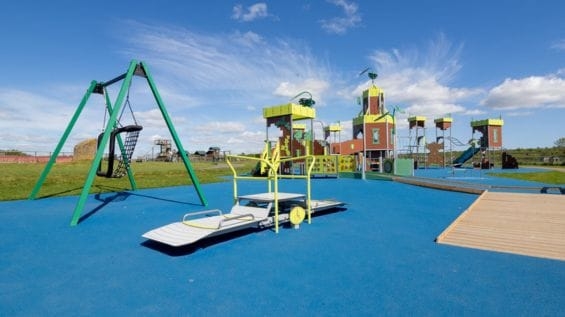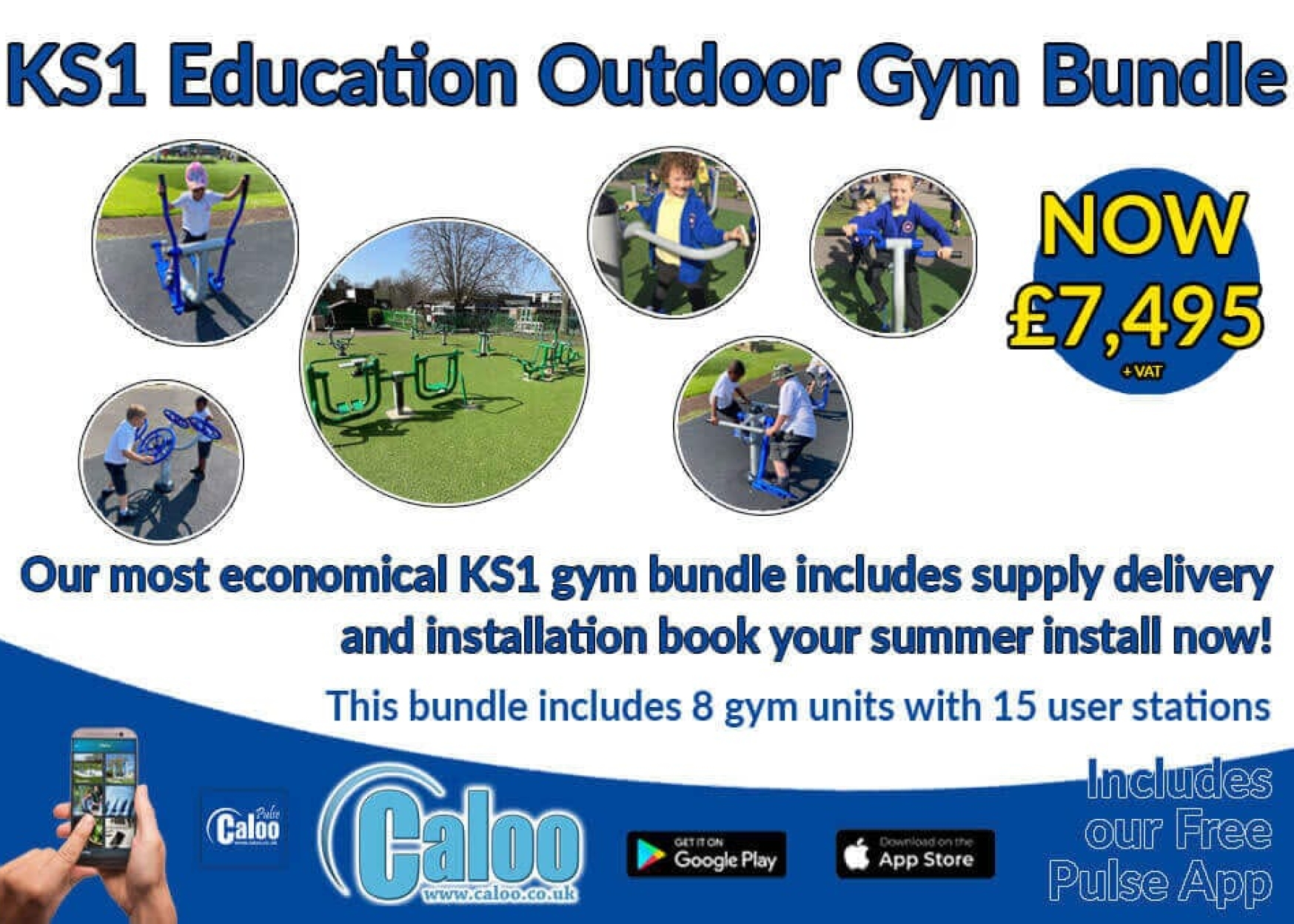
Jun

Inclusive Playground Equipment Ideas That Encourage Equal Play
Playgrounds are more than just spaces to have fun—they’re where friendships are formed, imagination flourishes, and crucial developmental skills are nurtured. But for children with disabilities or different learning needs, play can often become a source of exclusion. That’s why inclusive playground design is so essential.
Inclusive playground equipment includes features like wheelchair-accessible ramps, ground-level sensory panels, basket swings, and quiet zones. These elements ensure children of all abilities can play together safely, comfortably, and equally—encouraging social interaction, physical development, and inclusive fun for everyone.
At Caloo, we believe every child deserves equal access to outdoor play, no matter their ability. From wheelchair-accessible equipment to sensory-rich features, our inclusive playground solutions are designed to ensure no child is left behind. In this blog, we’ll explore practical, inspiring inclusive playground equipment ideas that promote equal play and support children of all abilities to thrive.
What Is Inclusive Playground Equipment?
Inclusive playground equipment is purposefully designed to be accessible, engaging, and beneficial to children of all abilities—physical, sensory, cognitive, and social. It removes barriers to participation, allowing children to play together in a space that values diversity and encourages collaboration.
Inclusive play isn’t just about adding a ramp or a single adapted swing. It’s about designing a holistic space where every child, regardless of ability, can interact, explore, and engage meaningfully. At Caloo, our approach to inclusive playgrounds considers surfacing, layout, equipment variety, and user experience to ensure truly equal play opportunities.
Why Inclusive Playgrounds Matter
Outdoor play has significant physical, social, and emotional benefits for children. However, traditional playgrounds often fail to accommodate children with mobility challenges, neurodiverse needs, or sensory sensitivities. This exclusion can lead to isolation, lower confidence, and reduced physical activity, which runs counter to the goals of inclusive design as supported by the Equality Act 2010.
By creating inclusive playgrounds, we enable:
• Equal social opportunities
• Improved physical development for children of all abilities
• Community integration and empathy building
• A sense of belonging and independence
For schools, councils, developers, and community groups, investing in inclusive play is an investment in happier, healthier children and more connected neighbourhoods.
Key Principles of Inclusive Playground Design
Before selecting equipment, it’s important to understand what makes a playground truly inclusive. Here are five core design principles Caloo follows:
1. Equal Access and Engagement
All children should be able to enter, navigate, and enjoy the playground safely and independently. That includes wheelchair users, children with visual impairments, or those needing sensory regulation.
2. Varied Play Opportunities
Play should offer a mix of physical, social, and sensory activities. This ensures children can choose the kind of play that best suits their mood, ability, and energy levels.
3. Accessible Surfacing
Surfacing such as bonded rubber mulch, wetpour, and SUDS Bond provides a smooth, safe base for wheelchair users and children with mobility aids
4. Multi-Sensory Engagement
Inclusive playgrounds engage more than just muscles—they stimulate touch, hearing, sight, and even emotional awareness through creative play zones.
5. Thoughtful Layout and Flow
Equipment placement should allow for quiet corners, open pathways, and space for carer support, ensuring freedom and comfort throughout the space.
Inclusive Playground Equipment Ideas That Work
Let’s dive into some practical and popular equipment choices that encourage inclusive, accessible play.
1. Ground-Level Activities
Ideal for: Wheelchair users, children with limited mobility, sensory seekers
Examples:
• Musical play panels
• Role-play stations
• Tactile walls and texture boards
• Sand and water trays
• Low-level climbing frames
Why do they work?
These features are easy to access, require no steps or transfers, and foster inclusive group interaction. Musical panels and water play are especially effective for neurodiverse children who thrive on sensory stimulation.
2. Ramps, Transfer Stations, and Wide Pathways
Ideal for: Wheelchair users and carers
Examples:
• Ramp access to elevated play towers
• Transfer platforms for slides and bridges
• Extra-wide bridges and steps with handrails
Why do they work?
These adaptations let children with mobility aids participate in elevated play experiences alongside their peers, encouraging inclusive adventure without feeling segregated.
3. Inclusive Swings and Seesaws
Ideal for: Children with physical disabilities, ASD, or learning difficulties
Examples:
• Basket (group) swings
• Wheelchair-accessible swing seats
• Inclusive seesaws with back support
Why do they work?
Multi-user swings and seesaws encourage shared fun. Basket swings are ideal for children who prefer gentle motion, and can even accommodate children and carers together.
4. Sensory Play Zones
Ideal for: Autistic children, ADHD, sensory seekers
Examples:
• Spinning panels and wheels
• Textured panels with braille
• Chimes, drums, and xylophones
• Light-reflective or colour-focused surfaces
Why do they work?
These elements help regulate emotions, improve focus, and offer calming experiences. Sensory-rich play also appeals to all children, not just those with identified additional needs.
5. Quiet and Retreat Spaces
Ideal for: Children with sensory sensitivities or social anxiety
Examples:
• Play huts and small dens
• Secluded seating areas
• Shaded, enclosed spaces
Why do they work?
Everyone needs a break sometimes. Retreat zones allow children to reset, rest, or observe from a distance without leaving the play area entirely. This ensures emotional safety as well as physical.
Real-Life Example: Community Park for All Abilities
At Caloo, we’ve worked with schools and councils across the UK to bring inclusive visions to life. In one recent project, we helped transform a local green space into a fully accessible community playground. Key features included:
• A basket swing installed near a wheelchair-friendly pathway
• A central sensory zone with interactive music and tactile play walls
• Wetpour safety surfacing throughout for smooth, all-weather access
• An open layout encouraging free movement and social interaction
The result? A thriving community hub where children of all abilities can play side-by-side, supported by features that celebrate their differences while fostering connection.
Practical Tips for Planning an Inclusive Playground
If you’re a school leader, parish council, developer, or community group exploring inclusive playground design, here are a few tips to get started:
1. Consult With the Community
Speak with parents, carers, SEND coordinators, and children themselves. Find out what they need and want from the space.
2. Balance Active and Calm Zones
Ensure your design includes high-energy equipment as well as quiet, reflective areas.
3. Choose the Right Surfacing
Prioritise wheelchair-accessible and impact-absorbing surfaces such as bonded mulch, artificial grass, or rubber wetpour.
4. Partner With Experts
Work with a provider like Caloo who can handle consultation, design, installation, and maintenance—all while keeping inclusivity at the heart of every decision.
5. Think Long-Term
Inclusive play is not a one-off goal. Opt for durable, adaptable equipment and schedule regular inspections to ensure continued safety and accessibility.
Beyond Equipment: Inclusion as a Community Value
Inclusive playgrounds do more than meet accessibility standards—they show that a community cares. By choosing to invest in inclusive equipment, councils, schools, and housing developers send a powerful message: every child is welcome here.
Inclusive play encourages empathy among children, supports educational and physical development, and builds a sense of belonging for families who may often feel left out of public spaces.
At Caloo, we’re passionate about helping children of all abilities thrive. Our team of experts is here to help you create playground environments that uplift every user and enrich your community.
Ready to Build an Inclusive Playground?
Whether you’re looking to upgrade an existing space or start from scratch, Caloo can help you design and deliver an inclusive playground tailored to your users’ needs. We offer:
• Site-specific design and consultations
• Inclusive playground and gym equipment
• Accessible surfacing solutions
• Full installation and aftercare packages
Get in touch today to learn more about how we can bring your inclusive play project to life.

















